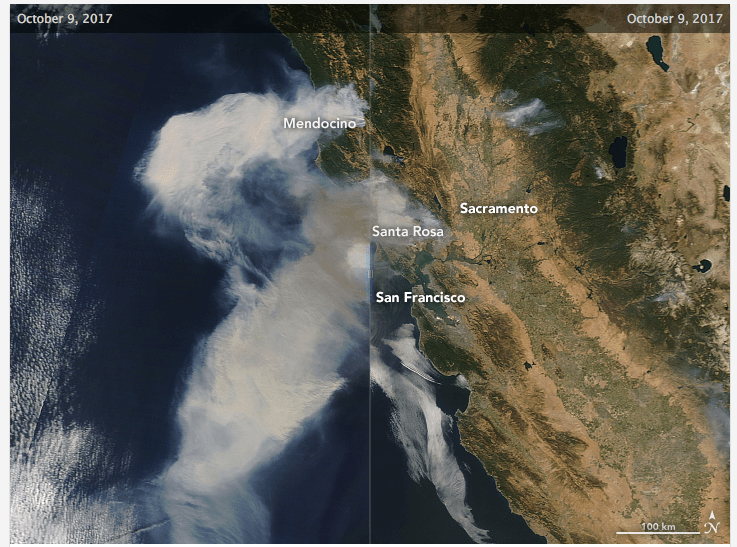We’re watching those out-of-control wildfires raging in California with horror, sorrow and a lot of empathy. Our hearts go out of the thousands of people watching their homes go up in flames. This drone footage posted by the Washington Post yesterday conveys the total devastation that wildfires can bring.
Sadly, Western US wildfires have become so common today that most of us can relate personal experiences of their speed and devastation. I vividly remember a 100-foot wall of flame rearing up as we fled Grand Teton National Park some 20 years ago – back when wildfires were still something of a novelty. Today, that “campfire smell” is an annual reminder that wildfire season has returned.
These current fires are just the latest in what has already been an intense wildfire season for California and the West – driven by this year’s extreme heat and years of drought. This article provides a good overview of the current atmospheric conditions driving today’s horrific California fires.
These California fires are not an isolated event. Over the last 30 years, the number of large, long-burning forest fires in the American West has quadrupled. More than half of Western states have experienced their largest wildfire on record since 2000. In California, 13 of the 20 largest wildfires on record have burned in just the last 17 years.
Explosive population growth during the same period has driven a housing boom, putting more homes in neighborhoods with high wildfire risks.
These infographics from the Union of Concerned Scientists (UCS) explain the multiple factors interacting to fuel western wildfires – and why we should expect more wildfires to come.
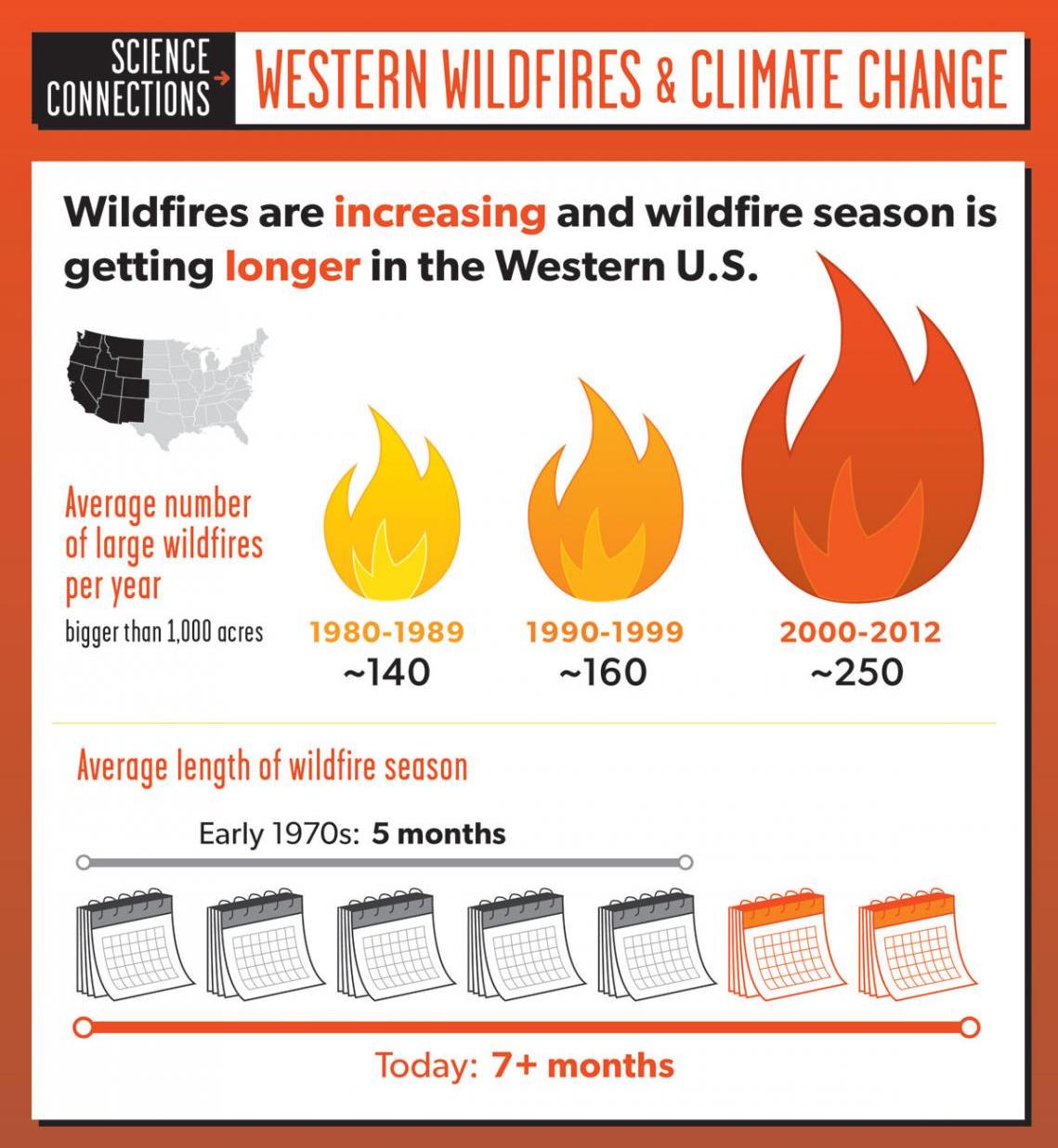
Panel 1: Wildfires and Wildfire Season
The number of large wildfires — defined as those covering more than 1,000 acres — is increasing throughout the region. Over the past 12 years, every state in the Western U.S. has experienced an increase in the average number of large wildfires per year compared to the annual average from 1980 to 2000.
Wildfire season is generally defined as the time period between the year’s first and last large wildfires. This infographic highlights the length of the wildfire season for the Western U.S. as a region. Local wildfire seasons vary by location, but have almost universally become longer over the past 40 years.
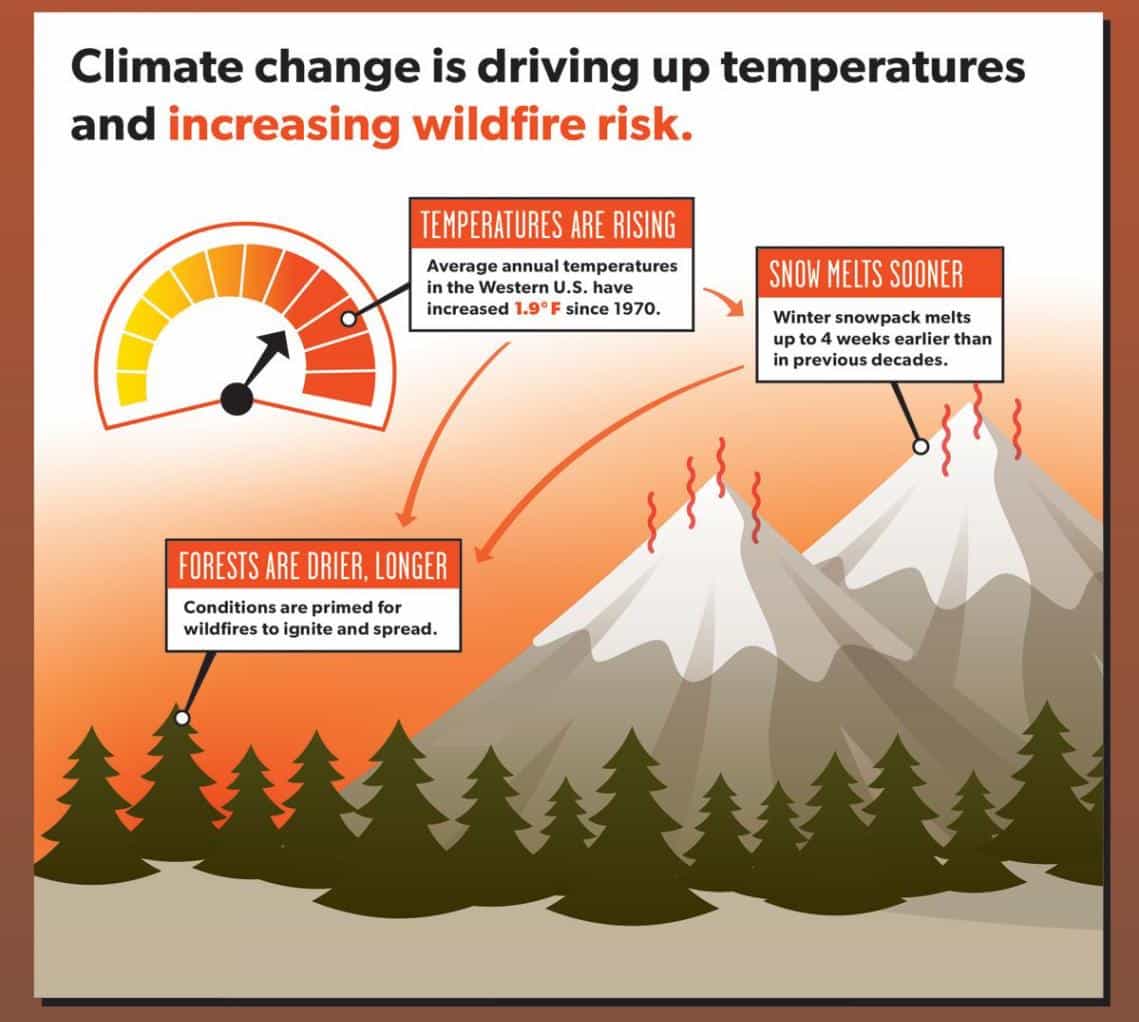
Panel 2: Rising Temperatures and Earlier Snowmelt
Temperatures are increasing much faster in the Western U.S. than for the planet as a whole. Since 1970, average annual temperatures in the Western U.S. have increased by 1.9° F, about twice the pace of the global average warming.
Scientists are able to gauge the onset of spring snowmelt by evaluating streamflow gauges throughout the Western U.S. Depending on location, the onset of spring snowmelt is occurring 1-4 weeks earlier today than it did in the late 1940s.
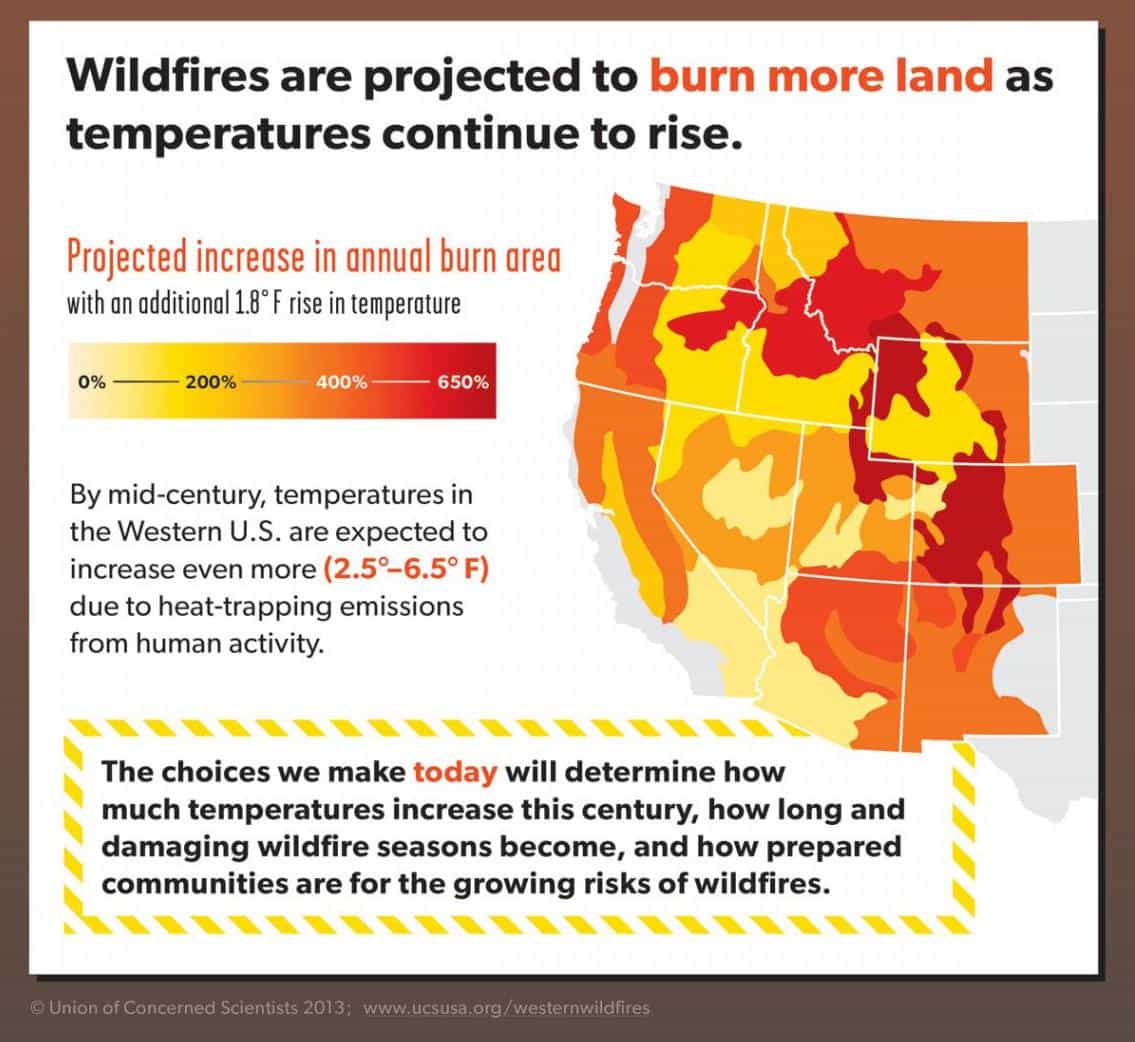
Panel 3: Future Projections
The projected increase in annual burn area varies depending on the type of ecosystem. Higher temperatures are expected to affect certain ecosystems, such as the Southern Rocky Mountain Steppe-Forest of central Colorado, more than others, such as the semi-desert and desert of southern Arizona and California. Every ecosystem type, however, is projected to experience.
The range of projected temperature increases in the Western U.S. by mid-century (2040 – 2070) represents a choice of two possible futures — from one in which we drastically reduce heat-trapping emissions (the projected low end of a lower emissions pathway) to a future in which we continue with “business as usual” (the projected high end of a higher emissions pathway).
Increased wildfires are affecting forested regions all around the world.
In June, 2017, Germany’s Deutsche Welle (an international broadcaster) posted a story about climate change and wildfires around the world. It’s a great, plain-English explanation of the scientific data supporting links between climate change and wildfires.1 Below are excerpts.
“… wildfire season – meaning seasons with higher wildfire potential – has universally become longer over the past 40 years. This trend is something Jason Funk, senior climate scientist with UCS, is very worried about.
“2015 was a record-breaking year in the US, with more than 10 million acres burned,” he told DW in an interview. “That’s about 4 million hectares, or an area of the size of the Netherlands or Switzerland.”
“It’s a scale we haven’t seen in recent history and it’s very concerning.”
According to Funk, not only US forests are endangered by increasing wildfires – the trend has been that wildfires are burning more area around the world.
“In recent years, there have been big fires in Siberia and various other places around the world where we typically don’t see large-scale wildfires,” he said.
Projections by the UCS suggest that wildfires could get four, five and even six times as bad as they currently are within this century…
Wildfires are typically either started accidentally by humans – such as a burning cigarette carelessly tossed out of a window – or by natural causes like lightning. These “ignition events” don’t have a major effect on the scale of the fire, says Funk. But what does affect scale are prevailing climate conditions. And these have become warmer and drier – due to climate change.”
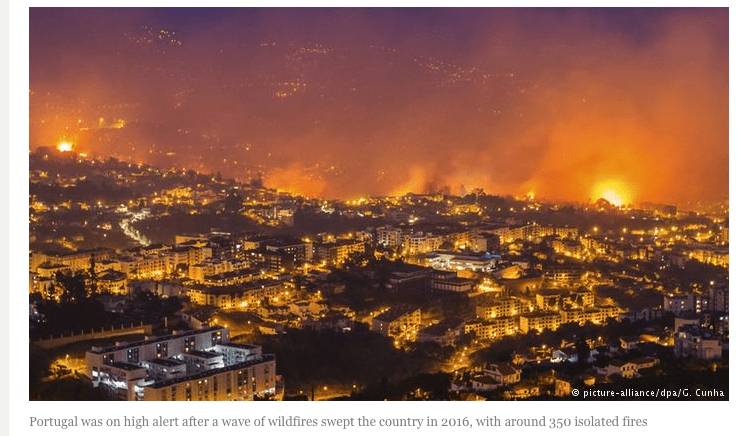
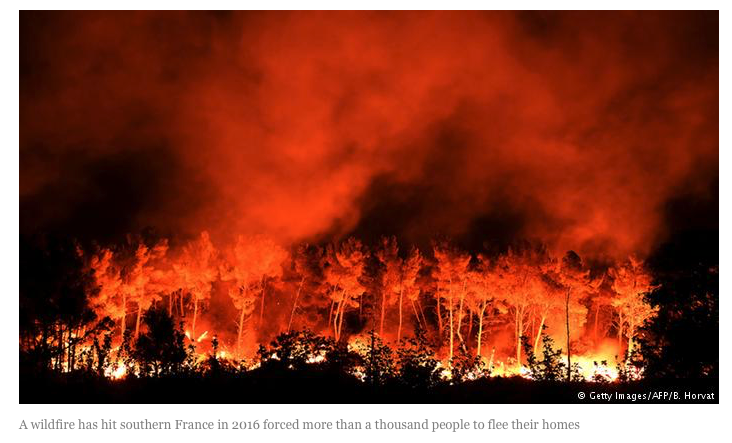
How are wildfires and climate linked?
“Greenhouse gas emissions, via the greenhouse effect, are causing the global temperature to increase and the climate to change. This enhances the likelihood of wildfires.
Why? Because warmer temperatures increase evaporation, which means the atmosphere draws more moisture from soils, making the land drier.
A warmer climate also leads to earlier snowmelt, which causes soils to be drier for longer. And dry soils become more susceptible to fire….
Drier conditions and higher temperatures increase not only the likelihood of a wildfire to occur, but also the duration and the severity of the wildfire.
That means when wildfires break out, they expand faster and burn more area as they move in unpredictable ways. “They really take off and get out of control more frequently than in the past,” said Funk.”
There are also multiplier effects.
“A less direct climate-driven effect is pest outbreaks that have killed a lot of trees. Pests make forests more susceptible to wildfire, according to Funk.
“We know that these pest outbreaks have been caused by climate change, because there hasn’t been anything like that in the past 500 years, perhaps even 1,000 years,” he said.
Insects are responding to warmer conditions, Funk explained, taking advantage of the longer summer season which grants them longer breeding circles and faster reproduction. “We can link those effects to the warmer temperatures that we’ve seen in the places where wildfires have been taking place.”
While human activities such as logging and mining are known to influence the likelihood of wildfires as well, many of the areas that have seen recent increases in wildfires are relatively unaffected by human land use.”
We’ll see more wildfires in future.
NOAA projects that the trend toward larger, longer wildfires will continue.
“Warming due to increasing greenhouse gas emissions will likely increase the potential for ‘very large fires’—the top 10 percent of fires, which account for a majority of burned areas in many regions of the United States. Climate change is expected to both intensify fire-friendly weather conditions, as well as lengthen the season during which very large fires tend to spread.
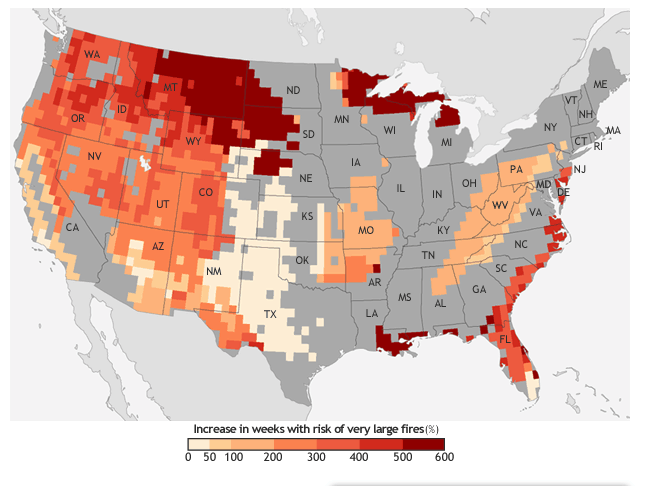
The map above shows the projected increase in the number of “very large fire weeks”—weeks in which conditions are favorable to the occurrence of very large fires—by mid-century (2041-2070) compared to the recent past (1971-2000). The darkest shades of red indicate that up to a six-fold increase is predicted across parts of the West. This area includes the Great Basin and Northern Rockies, as well as the Sierra Nevada and Klamath Mountains in Northern California.
More information?
California Increased Wildfire Risk
A good scientific summary of wildfire-related climate science in the western USA is at Increasing western US forest wildfire activity: sensitivity to changes in the timing of spring.
The National Climate Assessment (part of the U.S. Global Change Research Program) has an excellent on-line summary at how climate change is affecting forests worldwide.
1 Why, one wonders, does the US mainstream press not offer more coverage like this?
